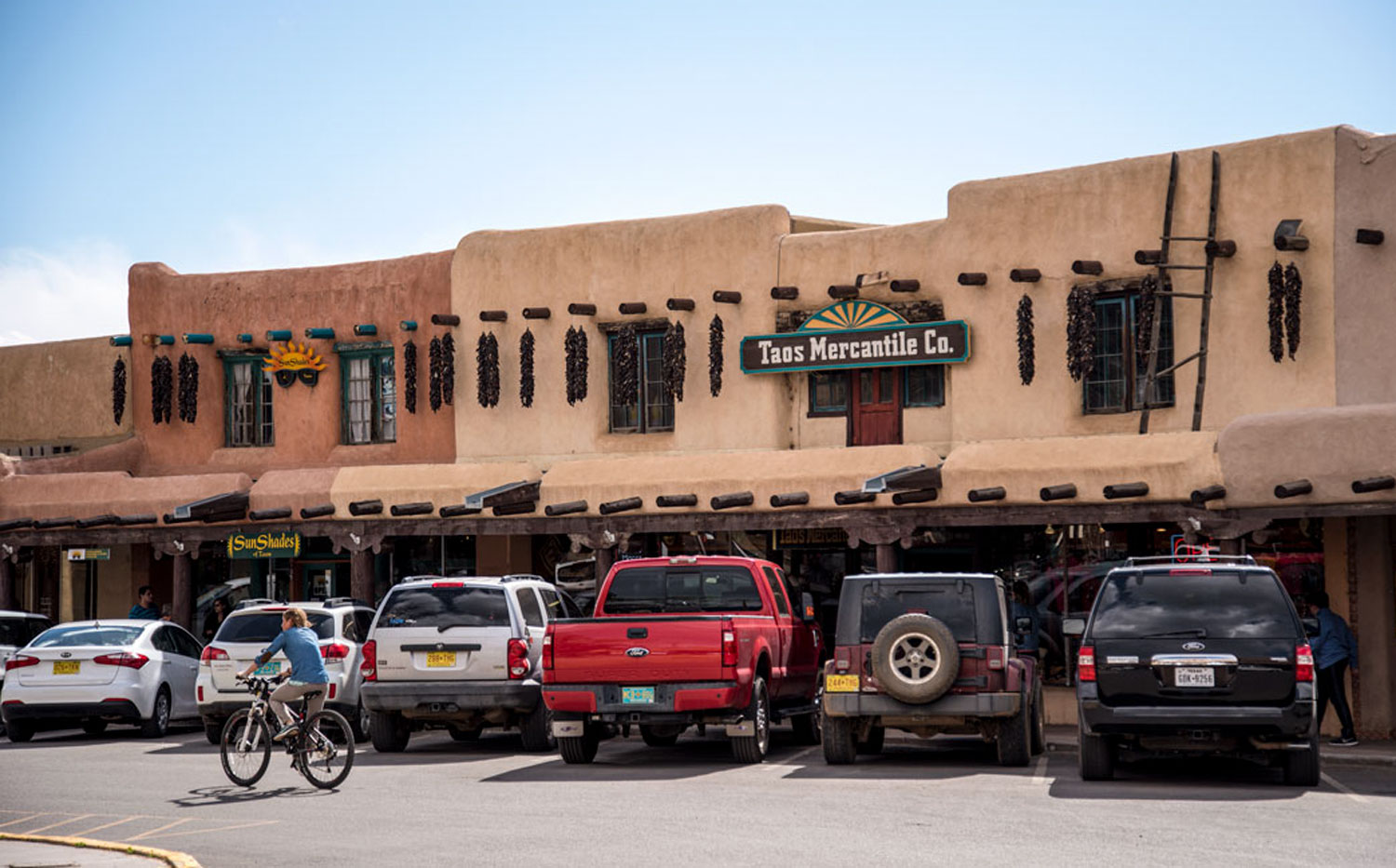The Booming and Broiling Southwest
Photos by Forrest Anderson
The American Southwest, long considered a realm of wide open desert spaces, has become one of the most urban and fast growing regions of the United States.
The area is home to some 56 million people. Phoenix, Arizona, is now the fifth largest city in the country in population, and Albuquerque, New Mexico, and Las Vegas, Nevada, are among the fastest growing cities. Utah, on the northern edge of the Southwest, is the fastest growing state, with Nevada, Arizona, and Colorado close behind. The population is expected to increase by nearly 70% by mid-century.
Moreover, 90 percent of the population is urban – the highest percentage of any region in the United States.
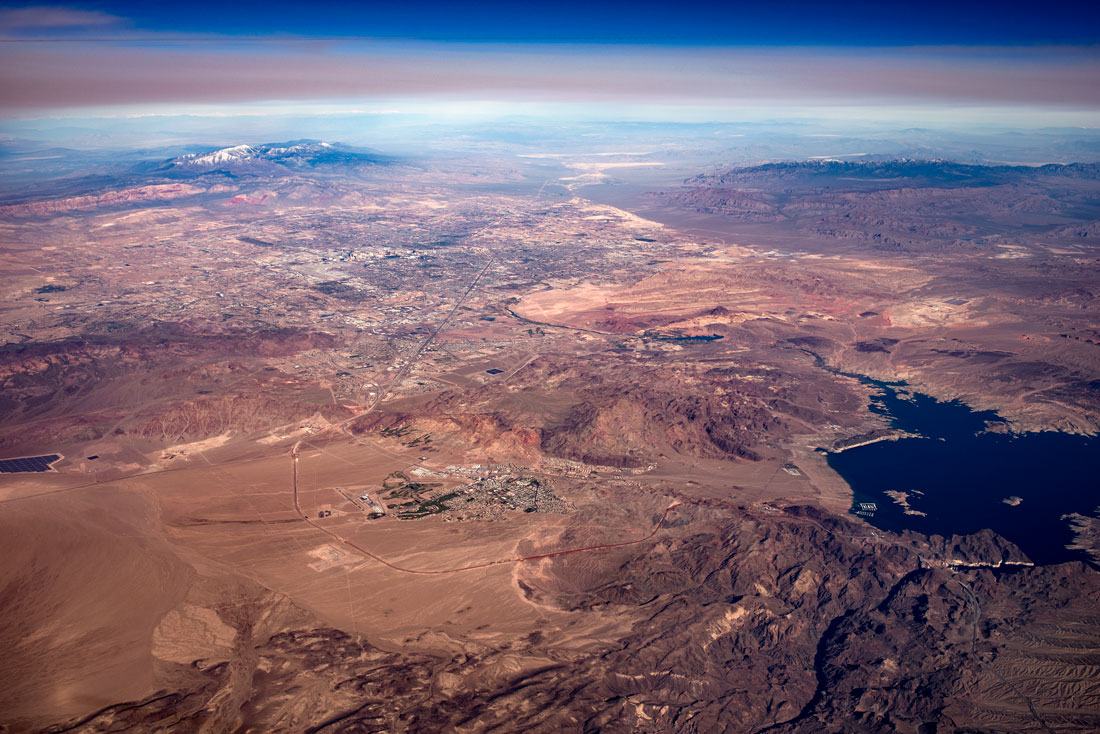
Las Vegas, Nevada, with Lake Mead in the lower right corner. As Southwestern cities expand, water and warming climates are the major concerns.
The result of the rapid migration to the Southwest is a vibrant mestizo culture that draws inspiration from the oldest regional culture in the nation and the diverse cultures of immigrants from throughout the world.
The term Southwest is not precisely defined in part because both ancient and modern cultures in the region have varied over time. The modern population is growing along with archaeological discoveries that continuously shift the boundaries of ancient southwest cultures.
The term Southwest originally was newly colonized lands immediately west of the Appalachian mountains. As the United States expanded west, the deep South was called the Southwest until today’s Southwestern states were added to the country. Today, Arizona and New Mexico are considered the Southwest’s core, with southern Utah, Colorado, and parts of Nevada and California also considered the Southwest. The term also has historical, ethnic, architectural and cuisine meanings.
History and Culture
Colorado, Arizona, New Mexico, Utah, Nevada and the states of Sonora and Chihuahua in northern Mexico are part of the Southwest cultural area. It is the oldest regional culture in the nation and arguably the most vibrant. It draws on three major cultures, all of which are themselves amalgams of cultures that preceded them.
Native cultures of the Southwest may date back as early as 25,000 B.C in what are today southern Utah, Colorado, Arizona, New Mexico, California and northern Mexico.
Modern native peoples of the region are largely descended from three ancient groups – the Anasazi or Ancestral Puebloans who built cliff dwellings and other major sites in Arizona, New Mexico, Utah and Colorado; the Hohokam who built complex irrigation systems to grow crops in Arizona; and the Mogollon who hunted and farmed along rivers in western New Mexico and eastern Arizona. The earliest of these cultures dates from 1500 B.C. Evidence of maize, cotton and tobacco growing dates back to about 1,200 BC in the Tucson basin of Arizona.The three cultures declined by about 1500 and modern tribes emerged from their descendants and others such as the Apaches who had moved into the area. The oldest continuously inhabited village in the United States is the Hopi community of Old Oraibi in northern Arizona, which was founded in about 1050 B.C.
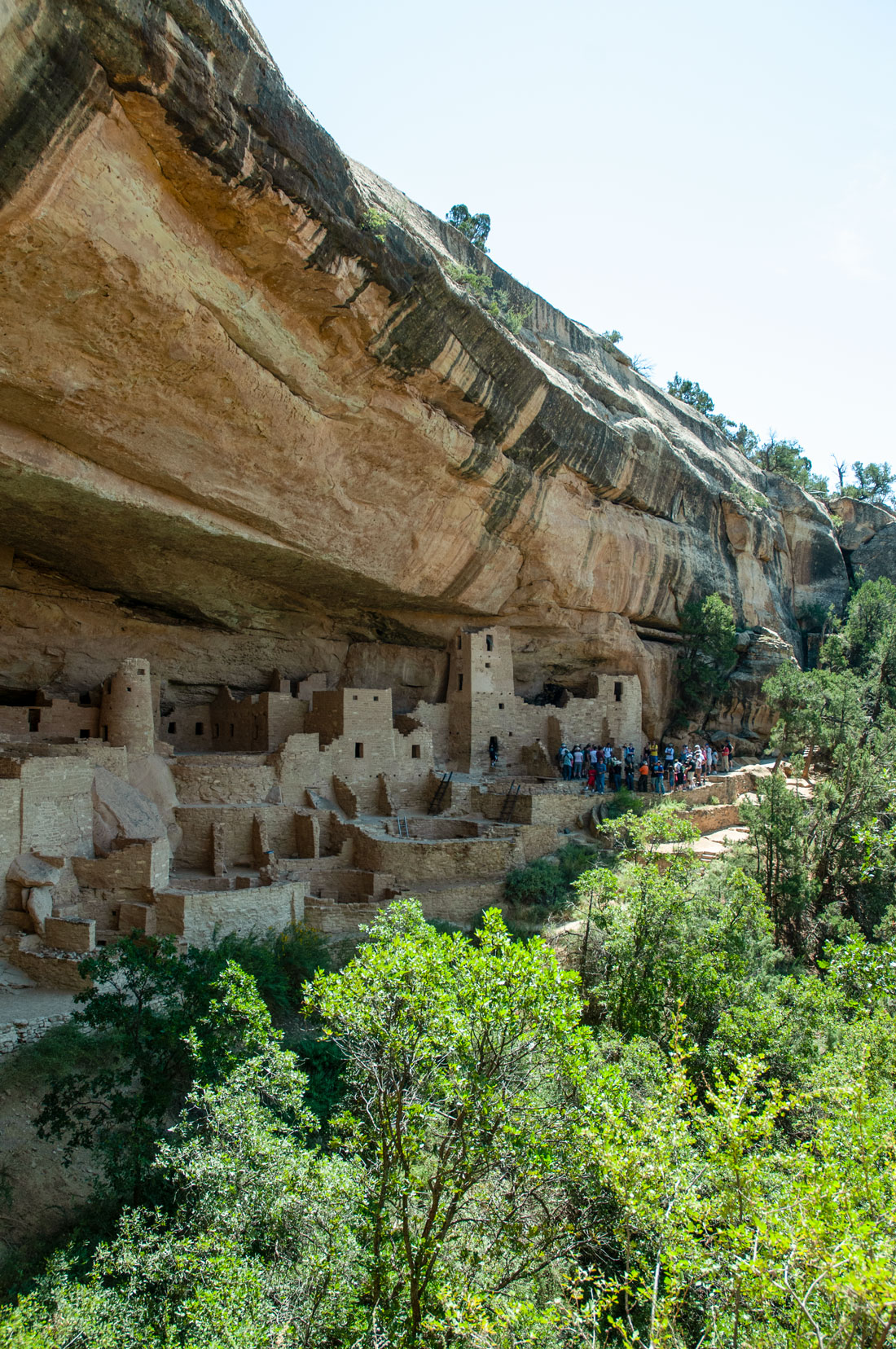
An Ancestral Puebloan cliff dwelling at Mesa Verde, Colorado.
Modern Puebloans are descendants of the Ancestral Puebloans. The Puebloans built the terraced adobe houses from which the region draws its architectural inspiration and raised cotton which they wove into blankets and clothing. They raised maize, beans and squash which form the foundation of Southwestern cuisine.
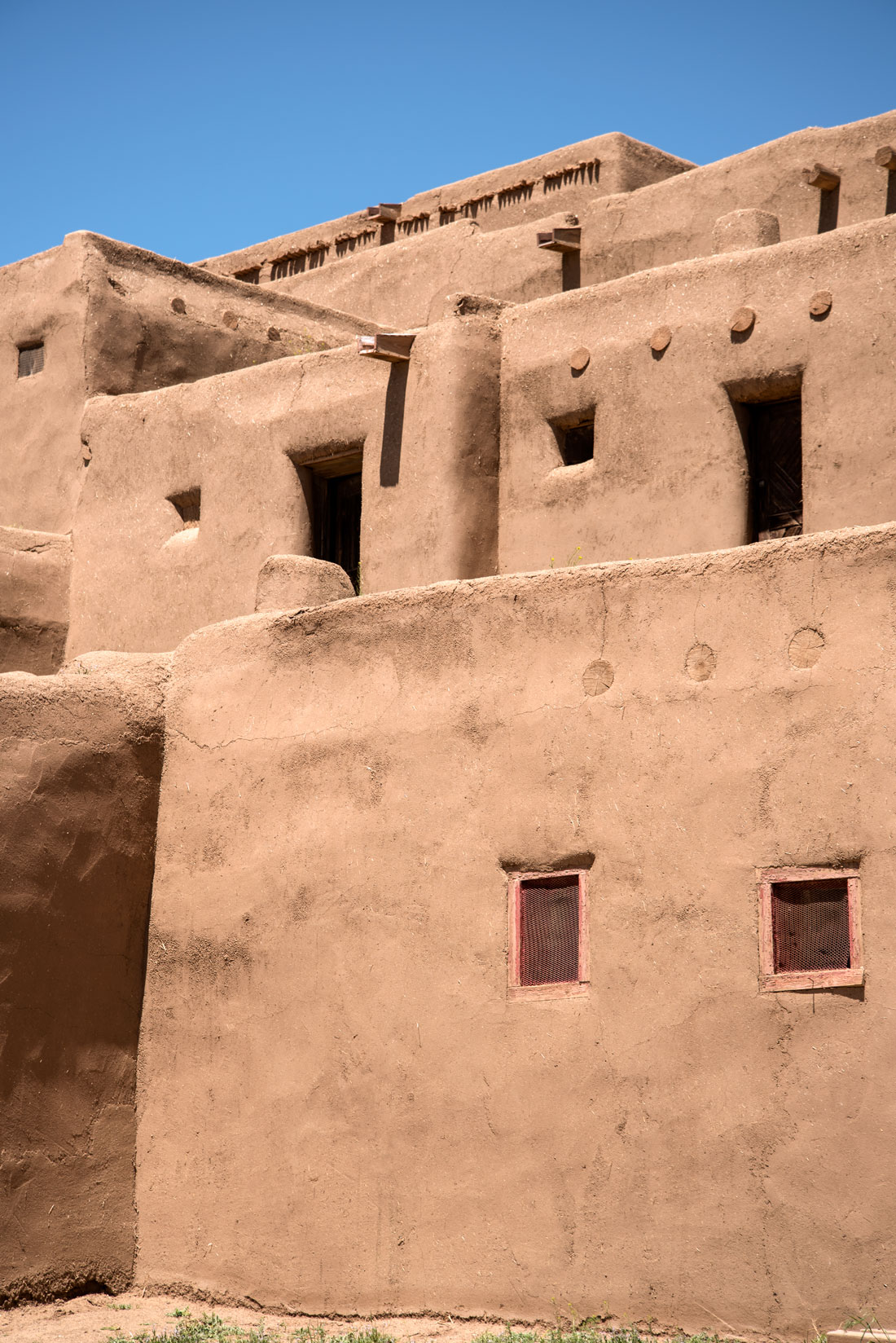
A large multi-storied adobe building at Taos Pueblo, New Mexico.
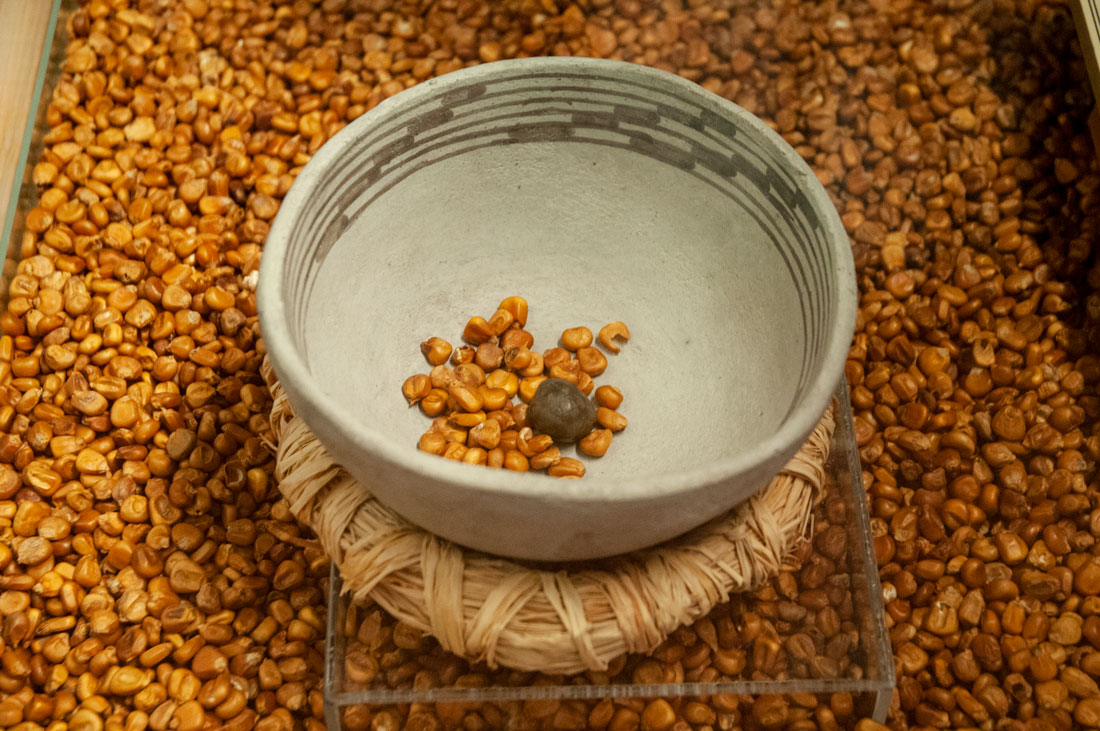
From ancient times, corn has been the staple of the Southwest.
South of them, the Pima and Yaqui who had cultural roots in Mexico and probably were descendants of the Hohokam, grew melons, pumpkins and maize and built large houses with grass-covered mud roofs. They were skilled farmers who enhanced the Hohokam irrigation system, which was among the largest in the ancient world, with dams, reservoirs and hundreds of miles of irrigation ditches. These peoples developed drought-resistant strains of maize and widely traded and stored it.
They were joined by Navajos and Apaches who migrated from the northwest about a thousand years ago. Originally hunters, they learned from the Puebloans how to grow maize and weave cotton.
In about 900, the Aztec Empire called the Southwest and northern Mexico Aztlán.
Native communities developed complex networks across the Colorado Plateau that linked hundreds of neighborhoods and regional population centers. Vast quantities of shell beads found in the Southwest are evidence that Ancestral Puebloans had very early links with the Southern California coast. Hohokam ball courts and cacao found on pottery suggest the Hohokam shared rituals with Meso America.
The Spanish arrived in the American Southwest from Mexico along long-established trade routes in about 1600. Having conquered the Aztec Empire, they considered Aztlán part of their territory. They were bent on finding riches, but also brought tools, plants, horses, sheep and the variety of Mexican chile that is today the foundation of Southwest cuisine.
European goods were sold at Indian trade fairs where local textiles, pottery, turquoise and maize had long been traded for Plains hides and dried meat. The Spanish also brought harsh methods of control that ushered in hundreds of years of persecution of native peoples. The Spanish massacred entire villages and enslaved others on ranches and farms. Spanish exploitation of native labor, forced conversion to Christianity and bans on Native American traditional ceremonies and rituals sparked an uprising in 1680 during which Puebloans captured the largest herd of horses ever taken by North American Indians. This laid the groundwork for the horse trade in the Southwest.
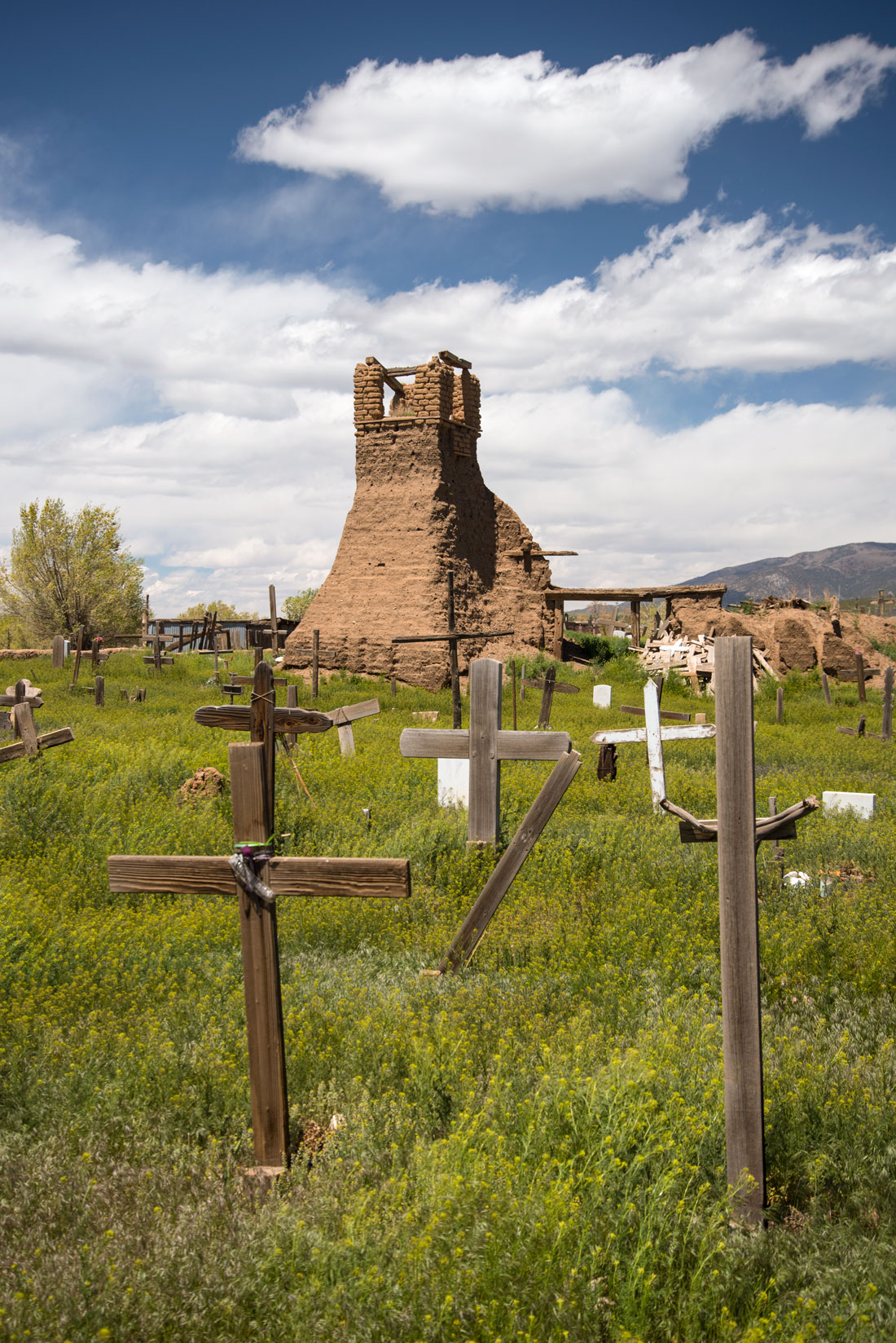
Cemetery at Taos Pueblo, New Mexico, where an uprising against the Spanish and then a brutal crackdown occurred.
The Navajo also raised sheep and horses after the Spanish brought them, wove colorful wool blankets and crafted fine silver jewelry. They lived in hogans or earth lodges.
Prior to the Spanish arrival, various native groups spoke more than 600 native dialects. After Spanish and other Europeans arrived, Native Americans also learned Spanish, English, and a sign language used for trade.
The Spanish brought diseases such as smallpox, measles and the plague that historians speculate reduced Native American populations to less than a tenth of their original numbers between the years 1500 and 1700.
The Spanish were a dominant military and cultural force for nearly 300 years. They made the Southwest an outpost of their empire, bringing the structure of religious orders, soldiers and colonists who built missions, presidios (forts) and towns with central plazas and churches. Some New Mexico cities are very old – Santa Fe was founded in about 1610, Albuquerque in 1706, Las Trampas in 1751, and Taos between 1780 and 1800.

A Catholic church in the Southwest. The Spanish brought Catholicism to the Southwest, adapting church architecture to the rustic adobe building style of the region. The Native-Spanish hybrid has become the iconic style of the Southwest.
Most Southwestern Native Americans believed in an almighty force that was the source of all life, the symbol of which was the sun. Some believed that the first people were created in a cavern in the earth, and they climbed through two caves to reach the surface. The world above the surface was sacred. Some tribes believed in a form of shamanism, in which a practitioner reaches altered states of consciousness to interact with a spirit world and channel energies into this world. They also believed that plants, animals, inanimate objects and forces of nature have spirits. Many contemporary Southwest traditions still incorporate aspects of animism and shamanism.
The Spanish ruled the area until Mexico achieved independence from Spain in 1821. In 1846, the United States won the Mexican-American War and wrested the Southwest from Mexico between 1848-1853. The federal government and U.S. settlers who streamed into the Southwest came into conflict with the native people over water and mineral rights. In a series of wars, entire native communities were destroyed. The natives pushed onto increasingly smaller reservations that lacked natural resources.
The Navajo had built up large herds of cattle, horses and sheep through raiding. Under U.S. governance, they continued to raid settlements in New Mexico. Fighting between them and the U.S. Army ensued, during which Navajo fields were burned, communities devastated and sheep slaughtered. After 17 years, the Navajo were facing starvation and surrendered. They were forced to march 800 miles to a 40-square-mile reserve at Fort Sumner, New Mexico, that lacked water and had poor soil. Two thousand Navajos died along the way. As a result of negative press about terrible conditions on the reserve, federal officials allowed Navajo to return to 10 percent of their original lands and later added more lands as the Navajo population grew.
At the time, the army promoted a policy of assimilation in which Native Americans were gathered on reservations and their children taught to read and write along with Christianity. Native people were forced onto reservations. Many were killed in the process and thousands more died from harsh conditions on the reservations.
The Apaches waged the Apache Wars against both Mexican and U.S. forces at about the same time. Their leader, Cochise, opposed efforts to relocate his people to a reservation in New Mexico. He finally made a peace agreement based on the government’s promise of reservation land for the Apaches in eastern Arizona.
When the United States took over the Southwest from Mexico, the Pueblo were the only Southwest tribe which had citizenship in Mexico. As Mexican citizens, they were automatically granted U.S. citizenship. However, because they were citizens, they didn’t have the rights and protections granted to federally recognized Native American nations and they lost much of the finest farmland in the Southwest as well as important religious sites. Some of their lands were restored in 1924, but the fight to obtain and keep water rights is still ongoing.
Statehood, railroads, exploitation of the area’s mineral resources and a tourist boom followed U.S. control of the Southwest. The United States added an Anglo influence with forts, trading posts, mining towns, cattle ranches, railroads and dams.
Southwest Native efforts in recent decades have focused on countering the negative impact of white influence on native people and preserving traditional Native American language and culture.
Today’s Southwest culture is a mestizo mix of Anglo, Hispanic and Native influences. There are large numbers of Hispanics in every major Southwest city. Albuquerque, New Mexico, is 47 percent Hispanic. Phoenix Arizona is 43 percent Hispanic. Tuscon is 41 percent, Las Vegas is 32 percent and Mesa, Arizona is 27 percent Hispanic. A large proportion of the population of many smaller towns and cities also are Hispanic American.
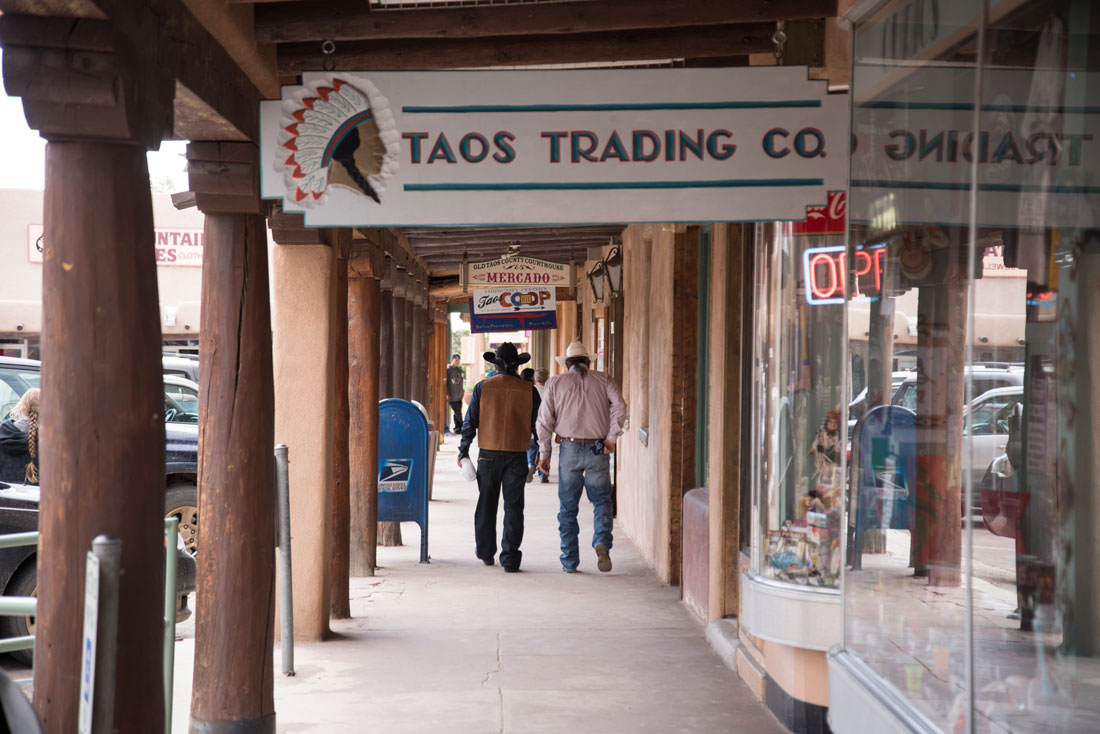
Southwest culture has spawned a popular architectural and interior design style influenced by indigenous culture, the Spanish occupation and the rusticity of the American West.
Southwest style blends Puebloan adobe construction with Spanish architecture and Mediterranean elements introduced by Anglo Americans in the 19th century. Walls are thick and help regulate the interior temperatures, roofs are tiled, windows are arched, and balconies are wood or wrought iron with window grills. Mission Revival architecture which drew inspiration from Californi’s Spanish missions also is part of the blend, although historic Spanish missions in Arizona and New Mexico were not built in the same style. Ranch houses also are popular as a result of the region’s cowboy tradition.

Adobe architecture above, and at a historic hacienda in Taos, New Mexico, below.
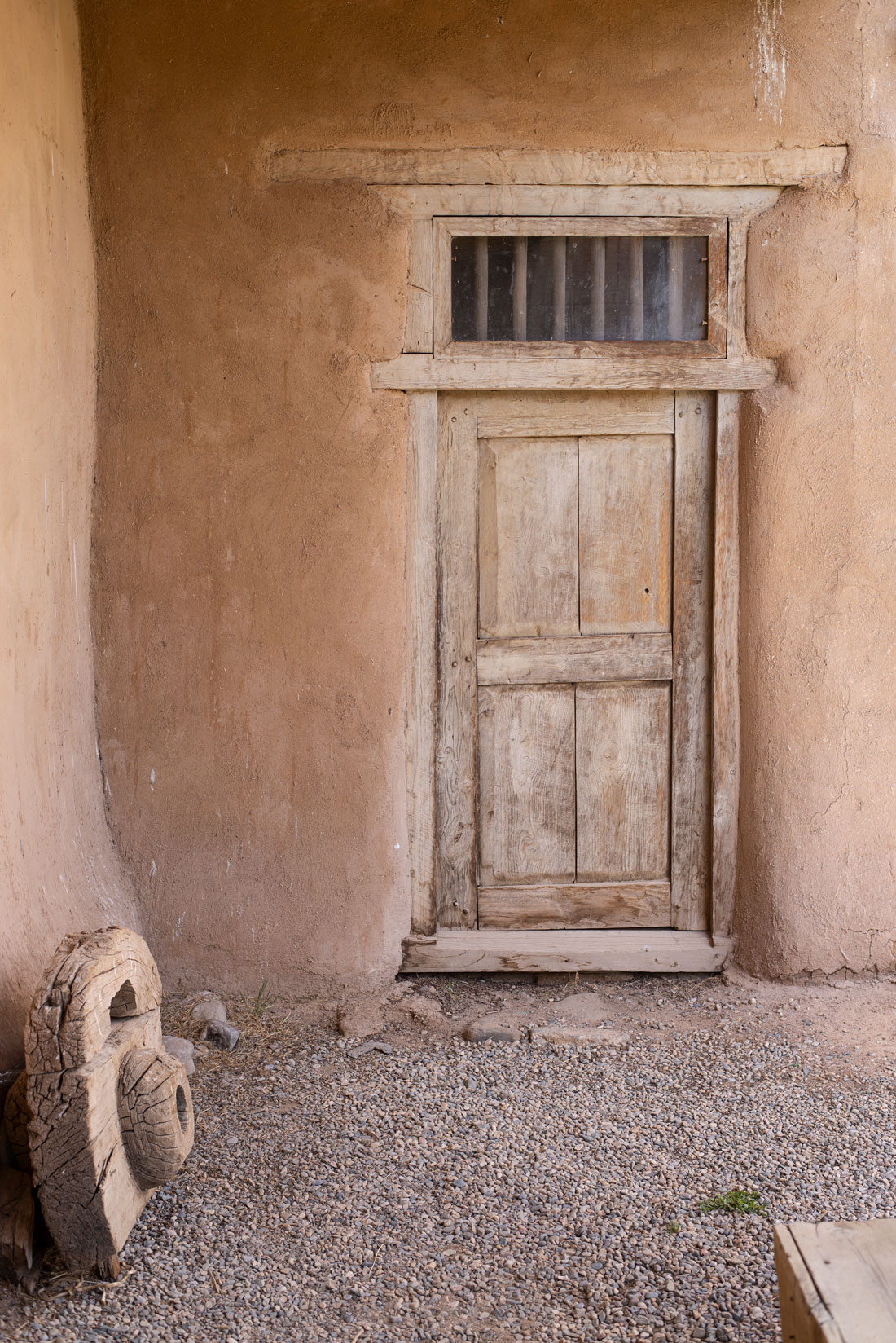
Southwest interior design is known for its earthy color palette of terracotta, turquoise, sunset coral, cream colored walls along with vibrant Native American and Spanish pottery, baskets and woven blankets, cowhide rugs and hammered metal accents. The style is casual, homey and comfortable.

Southwest interior decor draws upon historic elements from Native American culture, such as woven blankets and ladders used at multi-story Pueblo complexes.
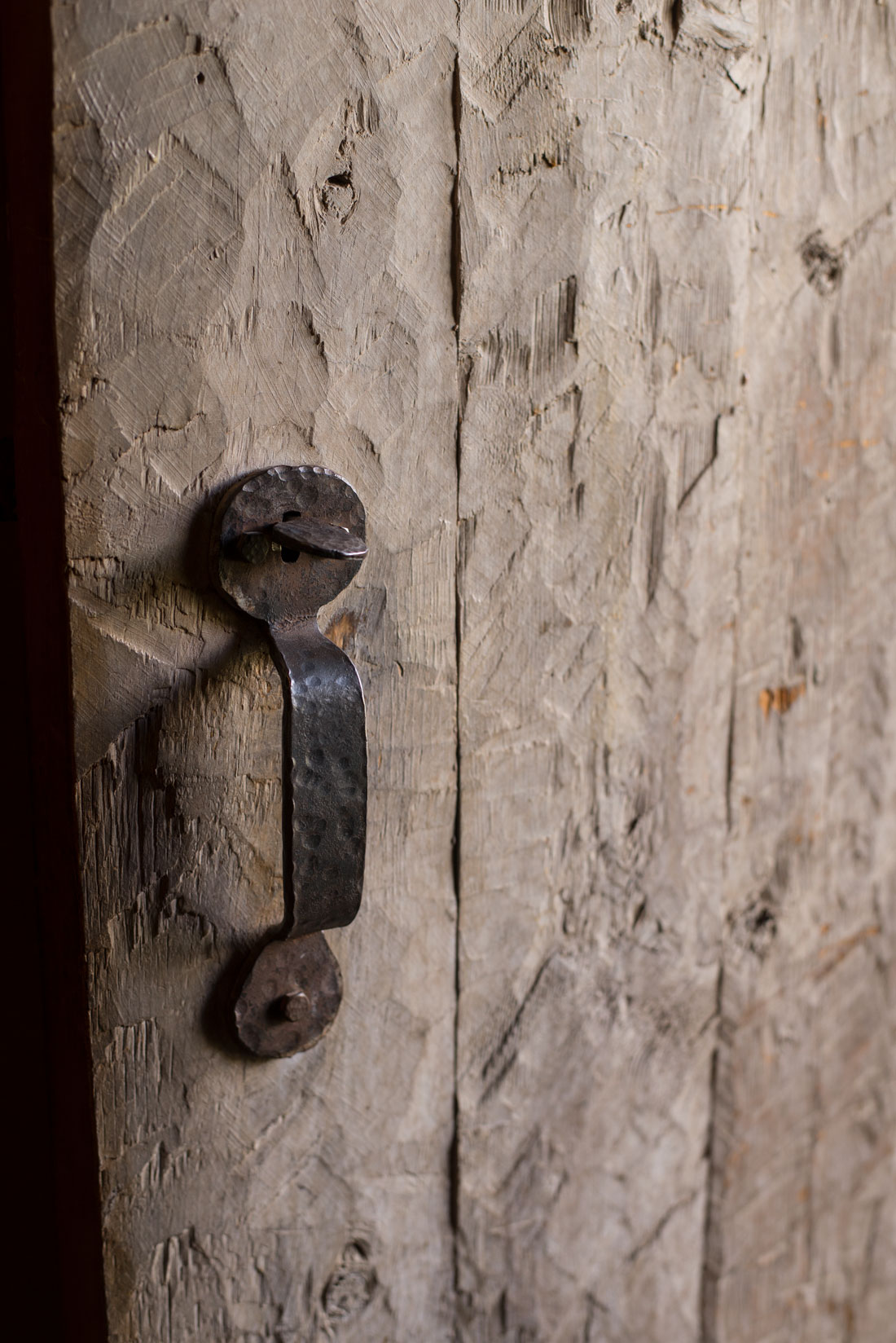
Hammered rustic hardware is a hallmark of Southwest style, borrowed from historic architecture of the region.
Southwestern cuisine, once the overlooked cousin of Mexican cooking, has come into its own with its fusion of Native American, Spanish and cowboy recipes. It has become one of the most innovative and flavorful regional cuisines in the United States.
It is known for its use of spices, especially New Mexico chilies, and dining in a casual atmosphere. Historically, the cuisine was made with locally grown food, meat, poultry and fish. Fruits and vegetables were sun-dried. Food was slow-cooked in pots over open fires. Only spices were imported. The railroad system expanded the cuisine by bringing in milled flour, sugar, lemons, oranges and other ingredients. Flour specialities such as fried dough called sopaipillas and traditional Navajo fry bread as well as paper-thin flour tortillas also became part of Southwest cuisine. Tortillas are deep-fried for chimichangas.
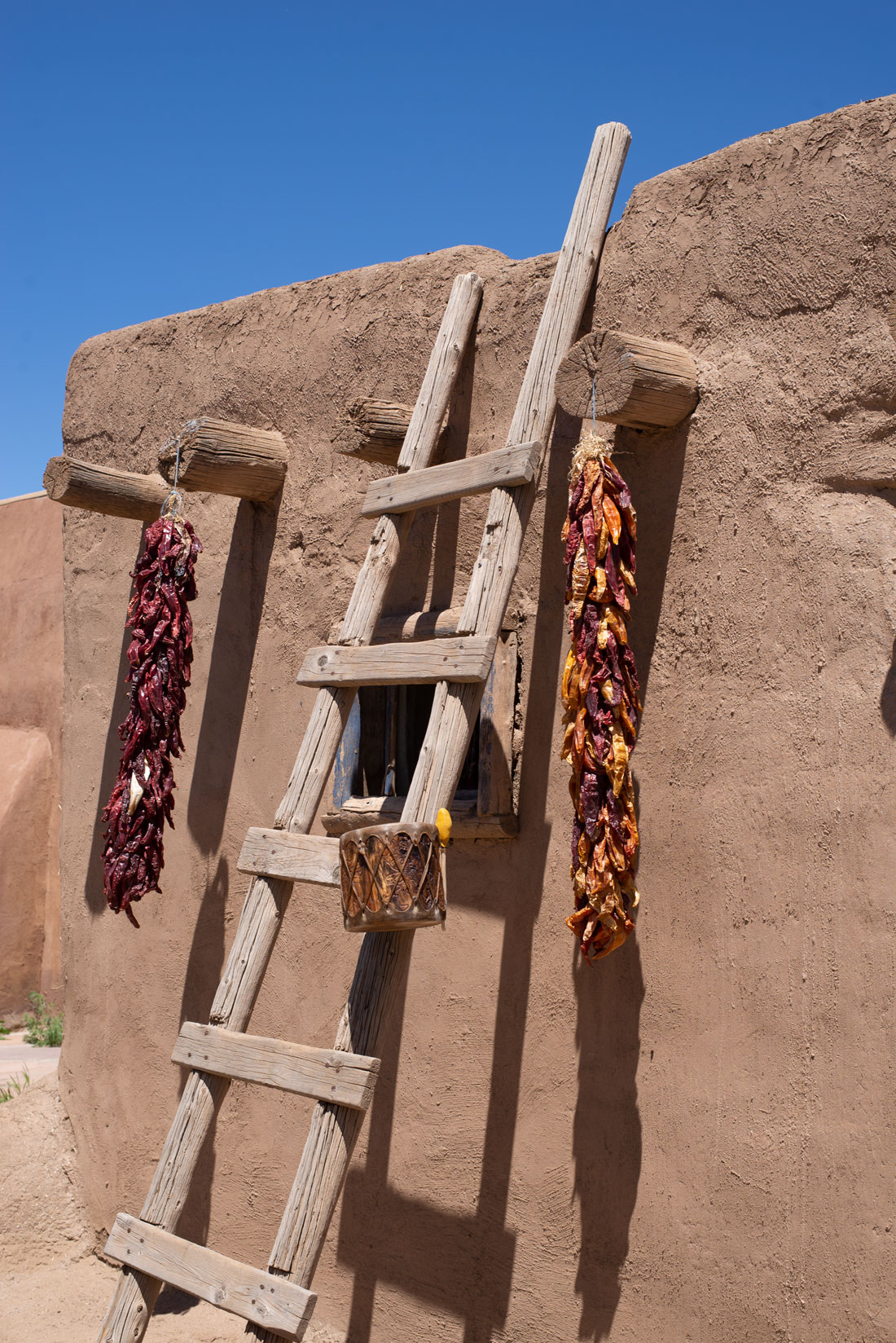
Chiles hung to dry at the ancient pueblo at Taos, New Mexico. Chiles are the preeminent spice used in Southwest cuisine.
Tamales, chile suppers and tostadas were added in the early 20th century. Beans and chile are used as filling for tostadas, tacos, burritos and similar dishes. Chile peppers also are combined with pizza, bagels, fried tempura, hot dogs and a variety of dishes from other cultures. Typically, meals are served with refried beans, guacamole and salsa. Salads and salsas are made with cholla cactus, gathered at the San Xavier Indian Reservation.
Southwest cities have populations of Middle Eastern, Asian, Central European, African and Latin American immigrants whose cuisines have been fused into Southwest culture by innovative chefs.
Native Americans’ adoption of Spanish-Mexican Southwest cuisine has been unfortunate, as it has combined with their genetics to create some health problems.
The corn traditionally grown by the Hopi and Pueblo peoples was blue, nutty and with higher protein content than yellow corn. Purple tortillas made from blue corn are a specialty of northern New Mexico. They are used for flat stacked enchiladas, but also in blue corn pancakes and blue corn tamales. My favorite is blue corn buttermilk biscuits.
In recent years, there has been a resurgence in interest in historic foods of the Southwest and Mexico, with many local restaurants specializing them. Chefs sometimes raise traditional crops and sustainable livestock.
Southwestern music is a subset of Western music, with indigenous, New Mexico and Tejano music styles.
Environment
The Southwest’s geography is mainly deserts and the Colorado Plateau, with the Colorado River and the Rio Grande running through them. There also are several mountain ranges with radically different flora and fauna than the deserts. The region has valleys that are below sea level and some of the highest mountain peaks in North America. The Chihuahuan Desert is the most biologically diverse desert in the Western Hemisphere.

Water is the most limiting resource in the arid Southwest.
The Colorado Plateau is characterized by plateaus, mesas, and canyons, the most dramatic of which is the Grand Canyon. The Southwest has spectacular painted deserts, lava formations and sand dunes.
This is a land of famous parks and monuments:
- Arizona - the Grand Canyon, Monument Valley, Petrified Forest, Saguaro, Agua Fria, Canyon de Chelly, Casa Grande Ruins, Chiricahua, Ironwood Forest, Montezuma Castle, Navajo, Organ Pipe Cactus, Pipe Spring, Sonoran Desert, Sunset Crater, Tonto, Tuzigoot, Vermilion Cliffs, Walnut Canyon, Wupatki, Apache–Sitgreaves and Tumacacori in Arizona.
- Southern California - Death Valley, Joshua Tree, Castle Mountains, Mojave Trails, Sand to Snow, the San Gabriel Mountains and Mojave National Preserve.
- Colorado - Great Sand Dunes, Black Canyon of the Gunnison, Mesa Verde, Browns Canyon, Canyons of the Ancients, Colorado, Hovenweep, Yucca House, Curecanti National Recreation Area, Bent's Old Fort Site, San Isabel, San Juan, and Uncompahgre.
- Nevada -Great Basin, Basin and Range, Gold Butte, Tule Springs Fossil Beds, Humboldt-Toiyabe National Forest, Lake Mead National Recreation Area, and Red Rock Canyon National Conservation Area.
- New Mexico - Carlsbad Caverns, White Sands, Aztec Ruins, Bandelier, El Malpais, El Morro, Gila Cliff Dwellings, Kasha-Katuwe Tent Rocks, Organ Mountains–Desert Peaks, Petroglyph, Rio Grande del Norte, Salinas Pueblo Missions, Chaco Culture, Pecos, Sevilleta, and the Apache, Carson, Gila, Lincoln, and Santa Fe national forests.
- Utah - Arches, Bryce Canyon, Canyonlands, Capitol Reef, Zion, Bears Ears, Cedar Breaks, Grand Staircase-Escalante, Hovenweep (also in Colorado), Natural Bridges, Rainbow Bridge, Dixie, and Manti–La Sal.
These fantastic natural landscapes are part of the attraction of the Southwest, but the environment’s limitations is the most likely factor that will limit the region’s breakneck population boom. The region’s biggest challenges, from ancient times to today, are limited water and warming temperatures. Increasing the population is exacerbating these perennial problems to an extent that has alarmed environmental experts for years.
As the West is facing drought, historic Native American adaptation to the arid Southwest environment is being scrutinized. The Native Americans adapted by building adobe houses with thick walls that were cool in summer and warm in winter. They were expert dry farmers who developed crops adapted to arid conditions and sophisticated irrigation systems.
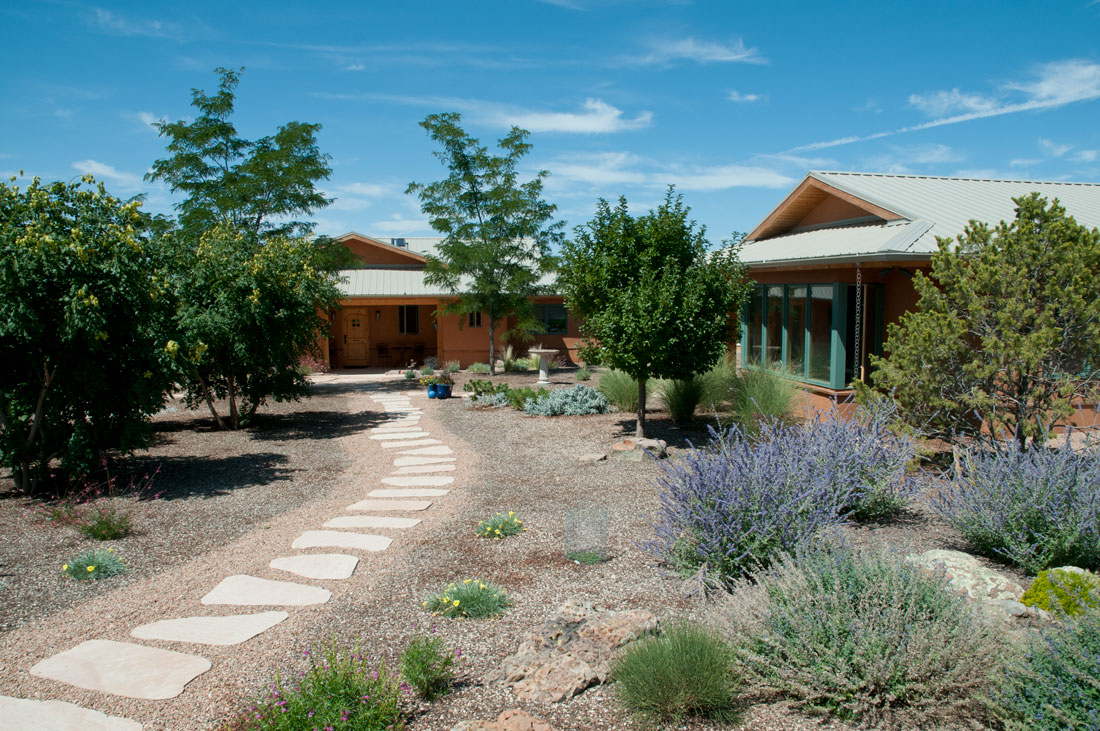
This modern eco-friendly home in Santa Fe, New Mexico, has thick adobe walls and lawnless landscaping that utilized rocks and drought-resistant plants. Such strategies are expected to become ever more prevalent in the West as droughts become more frequent and severe.
The central question of the region is how its modern inhabitants will adapt to warming temperatures and correspondingly reduced snowpack in the mountains.
More frequent and severe drought is expected to increase competition for water resources for cities, agriculture and energy in the area. Native American communities in particular are having a harder time accessing water, growing crops and medicinal and cultural plants and animals.
Drought, wildfire, invasive species, pests and changes in the geographic range of species are threatening native forests and ecosystems.
Average annual temperatures are expected to rise 3.5°F to 9.5°F by the end of the century. Droughts are expected to become more frequent, intense, and longer. Drought will affect important water sources, including the Colorado River Basin. Increased water demand and reduced supplies will add new stresses to already strained water resources.
The Southwest relies on slow melt of mountain snowpack in spring and summer. Snowpack helps keep the ground moist, delaying the fire season and reducing the number and severity of wildfires. Over the past half century, snow is coming later in the winter and snow melt has occurred earlier. Total yearly streamflow has decreased. Warmer temperatures are speeding the snow melting, and rain falling on snow is resulting in more rapid runoff and spring flooding. Higher temperatures are increasing evaporation from rivers and reservoirs. Groundwater levels are dropping.
At the same time, rapid population growth is increasing competition for water resources across sectors, states, tribes and between the United States and Mexico.
Native American communities are hit the hardest because they have some of the nation’s highest poverty rates and driest land. Some of their shallow wells have run dry, and they have experienced loss of crops and livestock.
The urban concentration of people is creating urban heat islands that are warmer than surrounding areas. Temperatures in the 110s are contributing to heat deaths and poor air quality that causes respiratory illnesses.
The electric grid is being strained by energy use for cooling during heat waves. Greater water demand in growing cities is straining water supplies.
Warmer, drier conditions have contributed to an increase in the size and frequency of forest wildfires, resulting in extensive destruction of homes, ecosystems, and high firefighting costs.
Most of the Southwest depends on irrigation for growing crops. Diverting water to urban areas can reduce the amount of water for crops. Warmer weather reduces crop yields and stress livestock, and a northward shift in agricultural production could occur.
All aspects of life in the Southwest, including where and how people build houses, how crops are planted, how forests are managed are expected to be influenced by climate change which will require decades of adaptation.
Check out these related items
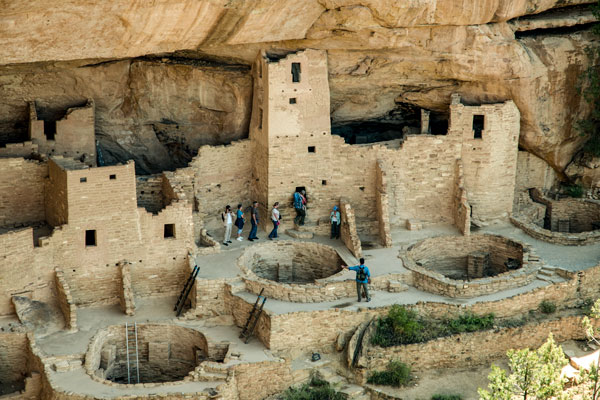
Reconstructing the Story of an Ancient Civilization
Researchers are piecing together an ever-clearer picture of the ancient civilization of the American Southwest called the Ancestral Puebloans.

Anatomy of an Enchilada
The wide variety of Mexican dishes can obscure their common underlying spice and preparation base.
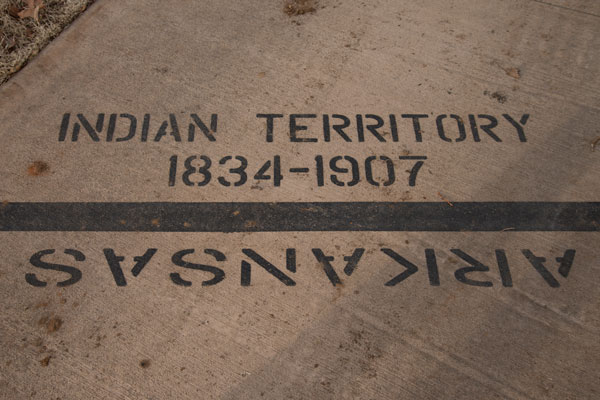
Nations Within a Nation
The first Native American to become U.S. interior secretary must deal with a fraught history of government-Native American relations.
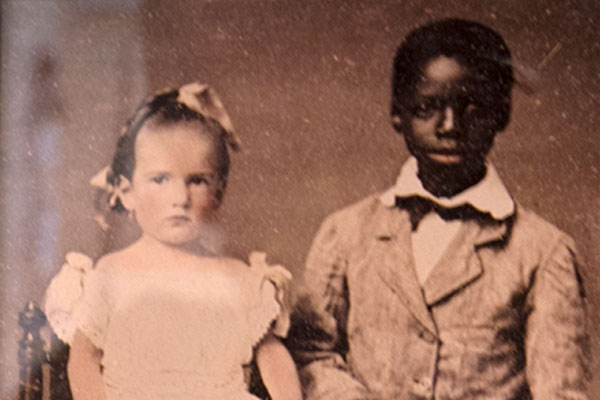
The History of Race in America
The racial history of the United States belongs to us all, with the responsibility to resolve the accompanying outstanding problems.

The River That Keeps on Giving
The mammoth Colorado River is the lifeblood of the southwest United States, supplying water and power for cities and agriculture.
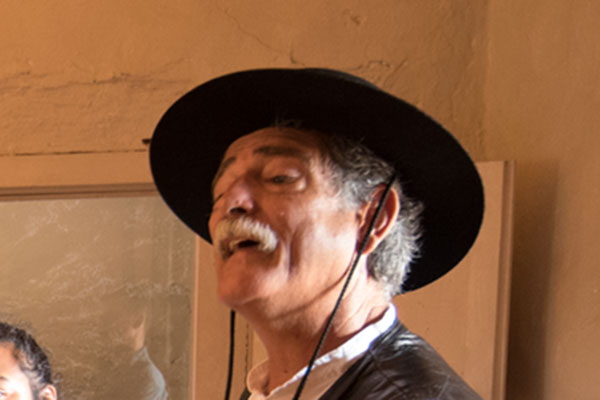
What does it mean to be Hispanic?
What does it mean to be Latino or Hispanic in the United States? This blog explores the ambiguous origins of these two terms.
